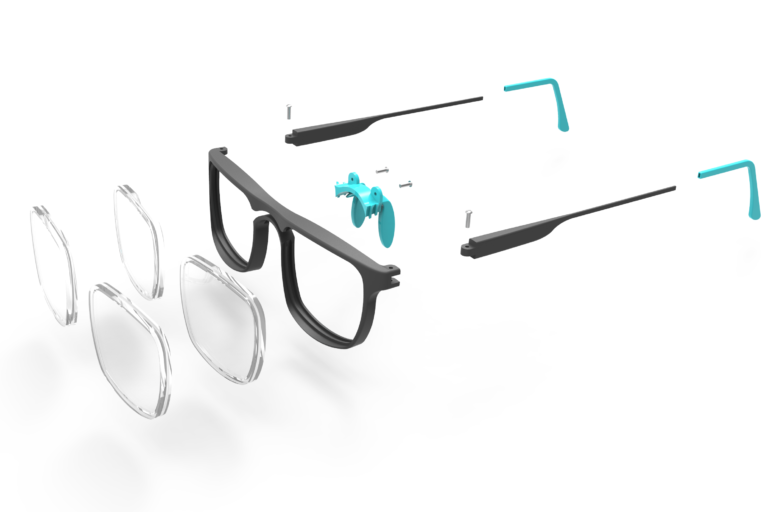Studies
This timeline provides an overview of all the training courses and studies I have completed. It started with Product development and more recently I have been specialising in Conversation Design and Accessibility Design. And I am always eager to learn more! 🤓
Sept. 2020
September 2020
Design for accessibility
Certified by Interaction Design Foundation
See Design for accessibility certificate
See Design for accessibility certificate
Everyone has to be able to use any (digital) product, right? Sadly, disabled people are often not taken into account when designs are being produced. I therefore wanted to learn how to design universally accessible products, and help improve the user experience of this particular target group.
This course helped me to become aware of the various accessibility pitfalls and more importantly, taught me how to avoid them.
After completing the course, I became actively involved in accessibility testing at KBC Bank. I discovered that showing how a user can struggle with seemingly ‘simple’ things, is an extremely powerful method for alerting management to the importance of accessibility. 😉
This course helped me to become aware of the various accessibility pitfalls and more importantly, taught me how to avoid them.
After completing the course, I became actively involved in accessibility testing at KBC Bank. I discovered that showing how a user can struggle with seemingly ‘simple’ things, is an extremely powerful method for alerting management to the importance of accessibility. 😉
June 2020
June 2020
Conversation Design
Robocopy-certified
See Conversation design certificate
See Conversation design certificate
After working for almost a year on the KBC chatbot it was time to learn the ‘theories’ behind designing good conversations, and broaden the knowledge I had gained simply through trial and error in the field.
The Robocopy course taught me a process that helps in particular to:
Below you’ll find some samples of conversations I helped design for Kate, KBC’s digital assistant.
- write clear and short utterances
- create the right expectations for users
- make sure you don’t forget important parts in your conversation such as repair flows or implicit confirmations
- create a strong conversational AI personality
- test and improve conversations
Below you’ll find some samples of conversations I helped design for Kate, KBC’s digital assistant.
Hospitalisation
What’s my hospitalisation insurance card number?
Here you go, your AssurCard number:
Licia Lopez Penalver
123456789012345
123456789012345
Shall I help you report a hospital admission?
Deeplink
My bank card was stolen!
OK. Don’t worry.
You can block your card here and you will automatically get a new one to replace it
Block card and get a new
Let me know if you have any more questions about this.
Small talk
Hi, what’s the meaning of life?
Rumour has it, it’s 42. But I can’t crunch the numbers myself yet. 🤓
Anything else I can help you with?
No thank you!
Alright, see you soon.
July 2017
July 2017
Product development
Master’s degree from the University of Antwerp (BE)
Go to the University of Antwerp website
Go to the University of Antwerp website
Creativity, culture, art and design have always been my passion. But what kind of job combines all of these with improving people’s lives and solving problems in general? A The designing profession of course! 😉
For my Master’s thesis I opted to design adjustable glasses for astigmatism (particular eye sight problem) sufferers in Madagascar.
Having rather severe astigmatism myself, I was really disappointed to discover adjustable eyeglasses were developed only for far-sightedness and near-sightedness.
These adjustable eyeglasses can be mass-produced ‘cheaply’ and users can easily adjust the strength of the lenses to restore sharp vision. These glasses are therefore particularly suitable for low-income countries where people can’t afford prescription glasses and trained staff for testing and prescribing glasses are often not available.
For my Master’s thesis I opted to design adjustable glasses for astigmatism (particular eye sight problem) sufferers in Madagascar.
Having rather severe astigmatism myself, I was really disappointed to discover adjustable eyeglasses were developed only for far-sightedness and near-sightedness.
These adjustable eyeglasses can be mass-produced ‘cheaply’ and users can easily adjust the strength of the lenses to restore sharp vision. These glasses are therefore particularly suitable for low-income countries where people can’t afford prescription glasses and trained staff for testing and prescribing glasses are often not available.
Adjustable glasses for astigmatism
Astigmatism
Astigmatism is an eye sight problem, in common with far-sightedness and near-sightedness, but more complex-shaped lenses are required to ensure proper astigmatism correction is achieved.
24%
of the world population suffers from an astigmatic condition requiring complex lenses.
Source: Hashermi, 2011
90%
of people with astigmatism have no correction.
Source: Resnikoff, 2008
± 90%
of people with uncorrected vision problems live in low-income countries
Source: Gwamuri, 2015
The main astigmatism symptoms are: a blurred and distorted vision, sore eyes and headaches.
Existing adjustable eyeglasses
All adjustable eyeglasses work following one of these mechanisms to make the lenses more concave or convex:
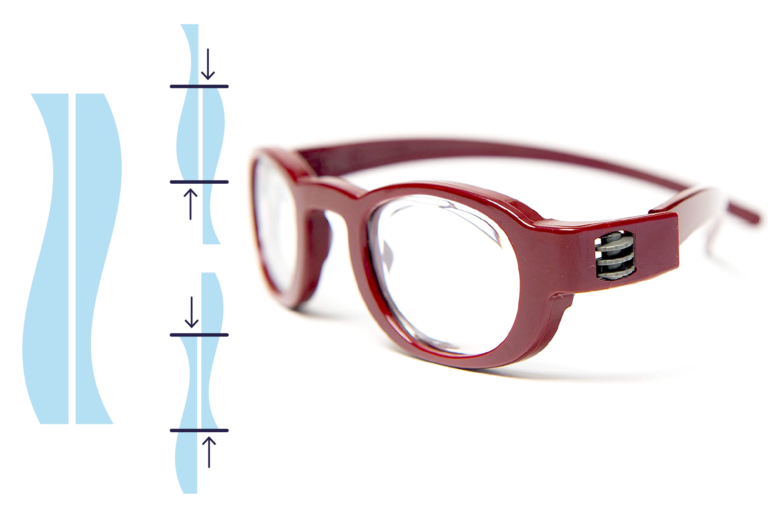
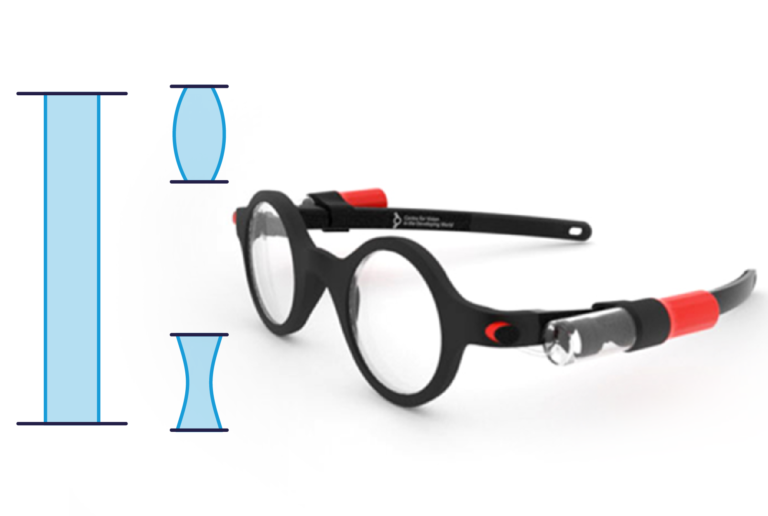
Madagascar
To gain a better understanding of how eye care services are provided in low-income countries, I decided to join Eyes for the World on their mission to Madagascar.
We screened around 1400 schoolchildren, 286 of whom were issued with adjustable glasses. 6 children with severe astigmatism subsequently received prescription glasses.
We screened around 1400 schoolchildren, 286 of whom were issued with adjustable glasses. 6 children with severe astigmatism subsequently received prescription glasses.
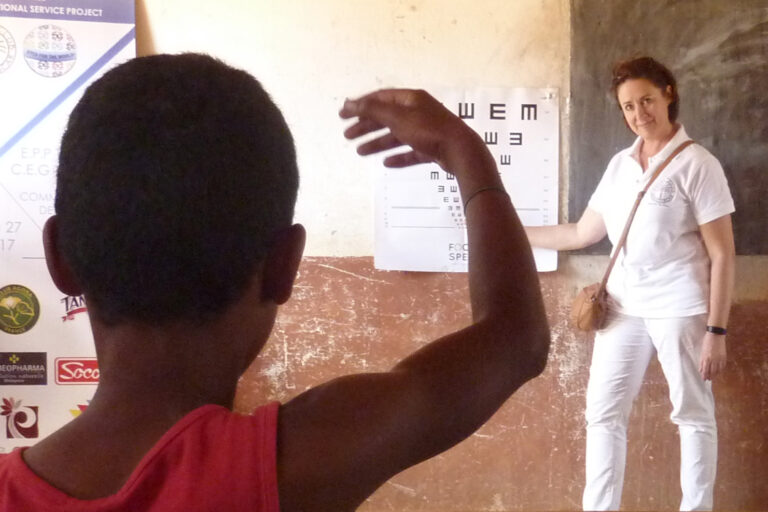
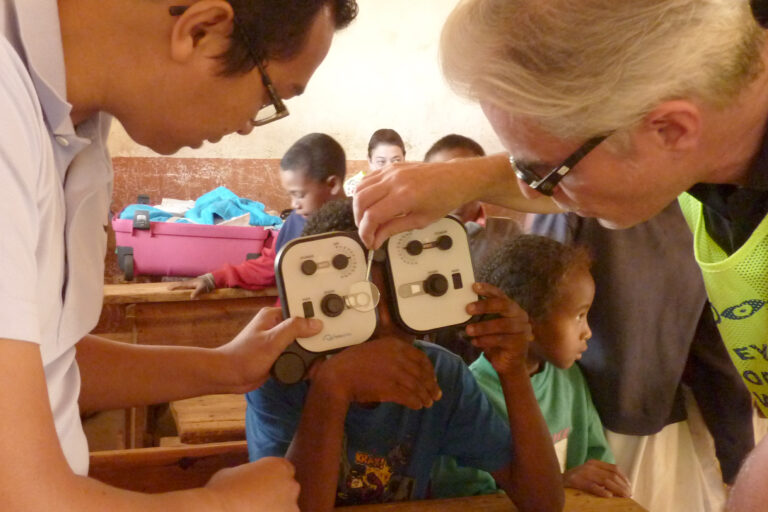
Vizi
The adjustable glasses I designed are called Vizi. They are adjustable in many ways: they can be adjusted according to correction strength, size and colour.
